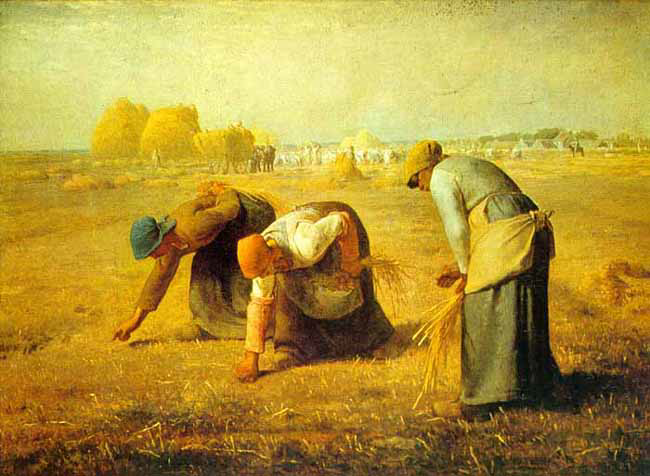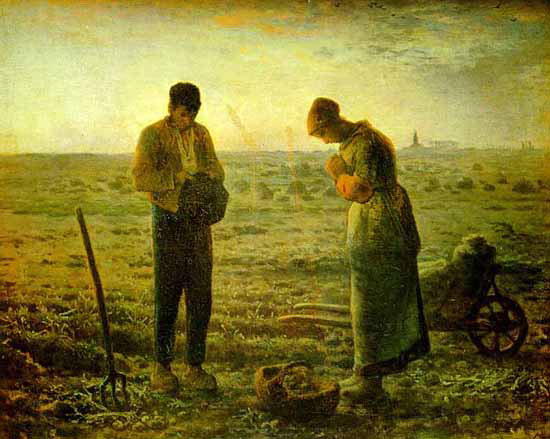밀레의 작품은 19세기 자연주의 작품이다.
이삭줍기
이삭을 줍는 아낙네들의 모습에서는 가시적으로 드러나는 노동의 이미지보다 무언가 성스러운 일을 하고 있는 고요함과 아름다운 자태가 느껴진다. 바로크 시대 얀 베르메르의 우유를 따르는 하녀 의 모습에서처럼.
Millet, Jean-Fran?is
--------------------------------------------------------------------------------
(1814-75) The son of a small peasant farmer of Gr?ille in Normandy, Millet showed a precocious interest in drawing, and arrived in Paris in 1838 to become a pupil of Paul Delaroche. He had to fight against great odds, living for long a life of extreme penury. He exhibited at the Salon for the first time in 1840, and married two years later. At this time, the main influences on him were Poussin and Eustache Le Sueur, and the type of work he produced consisted predominantly of mythological subjects or portraiture, at which he was especially adept (Portrait of a Naval Officer, 1845; Mus? des Beaux-Arts, Rouen).
His memories of rural life, and his intermittent contacts with Normandy, however, impelled him to that concern with peasant life that was to be characteristic of the rest of his artistic career. In 1848 he exhibited The Winnower (now lost) at the Salon, and this was praised by Th?phile Gautier and bought by Alexandre Ledru-Rollin, the Minister of the Interior. In 1849, when a cholera epidemic broke out in Paris, Millet moved to Barbizon on the advice of the engraver Charles-Emile Jacque (1813-94) and took a house near that of Th?dore Rousseau. Devoted to this area as a subject for his work, he was one of those who most clearly helped to create the Barbizon School. His paintings on rural themes attracted growing acclaim and between 1858 and 1859 he painted the famous Ang?us (Mus? d'Orsay), which 40 years later was to be sold for the sensational price of 553,000 francs.
Although he was officially distrusted because of his real or imaginary Socialist leanings, his own attitude towards his chosen theme of peasant life was curiously ambivalent. Being of peasant stock, he tended to look upon farmworkers as narrow-minded and oblivious of beauty, and did not accept the notion that `honest toil' was the secret of happiness. In fact, his success partly stemmed from the fact that, though compared with most of his predecessors and, indeed, his contemporaries, he was a `Realist', he presented this reality in an acceptable form, with a religious or idyllic gloss. Nevertheless, he became a symbol to younger artists, to whom he gave help and encouragement. It was he who, on a visit to Le Havre to paint portraits, encouraged Boudin to become an artist, and his work certainly influenced the young Monet, and even more decidedly so Pissarro, who shared similar political inclinations.
Although towards the end of his life, when he started using a lighter palette and freer brushstrokes, his work showed some affinities with Impressionism, his technique was never really close to theirs. He never painted out-of-doors, and he had only a limited awareness of tonal values, but his draughtsmanship had a monumentality that appealed to artists such as Seurat and van Gogh, who was also enthralled by his subject-matter, with its social implications. Millet's career was greatly helped by Durand-Ruel.
풍경과 인물을 떼어내도 2개의 완벽한 작품이 만들어질만한 명작이다.
생활고를 위한 노동의 모습이 아닌 경건한 분위기에서 고귀한 일을 하고 있는 젊은 부부의 모습이다.
이삭줍기
이삭을 줍는 아낙네들의 모습에서는 가시적으로 드러나는 노동의 이미지보다 무언가 성스러운 일을 하고 있는 고요함과 아름다운 자태가 느껴진다. 바로크 시대 얀 베르메르의 우유를 따르는 하녀 의 모습에서처럼.
Millet, Jean-Fran?is
--------------------------------------------------------------------------------
(1814-75) The son of a small peasant farmer of Gr?ille in Normandy, Millet showed a precocious interest in drawing, and arrived in Paris in 1838 to become a pupil of Paul Delaroche. He had to fight against great odds, living for long a life of extreme penury. He exhibited at the Salon for the first time in 1840, and married two years later. At this time, the main influences on him were Poussin and Eustache Le Sueur, and the type of work he produced consisted predominantly of mythological subjects or portraiture, at which he was especially adept (Portrait of a Naval Officer, 1845; Mus? des Beaux-Arts, Rouen).
His memories of rural life, and his intermittent contacts with Normandy, however, impelled him to that concern with peasant life that was to be characteristic of the rest of his artistic career. In 1848 he exhibited The Winnower (now lost) at the Salon, and this was praised by Th?phile Gautier and bought by Alexandre Ledru-Rollin, the Minister of the Interior. In 1849, when a cholera epidemic broke out in Paris, Millet moved to Barbizon on the advice of the engraver Charles-Emile Jacque (1813-94) and took a house near that of Th?dore Rousseau. Devoted to this area as a subject for his work, he was one of those who most clearly helped to create the Barbizon School. His paintings on rural themes attracted growing acclaim and between 1858 and 1859 he painted the famous Ang?us (Mus? d'Orsay), which 40 years later was to be sold for the sensational price of 553,000 francs.
Although he was officially distrusted because of his real or imaginary Socialist leanings, his own attitude towards his chosen theme of peasant life was curiously ambivalent. Being of peasant stock, he tended to look upon farmworkers as narrow-minded and oblivious of beauty, and did not accept the notion that `honest toil' was the secret of happiness. In fact, his success partly stemmed from the fact that, though compared with most of his predecessors and, indeed, his contemporaries, he was a `Realist', he presented this reality in an acceptable form, with a religious or idyllic gloss. Nevertheless, he became a symbol to younger artists, to whom he gave help and encouragement. It was he who, on a visit to Le Havre to paint portraits, encouraged Boudin to become an artist, and his work certainly influenced the young Monet, and even more decidedly so Pissarro, who shared similar political inclinations.
Although towards the end of his life, when he started using a lighter palette and freer brushstrokes, his work showed some affinities with Impressionism, his technique was never really close to theirs. He never painted out-of-doors, and he had only a limited awareness of tonal values, but his draughtsmanship had a monumentality that appealed to artists such as Seurat and van Gogh, who was also enthralled by his subject-matter, with its social implications. Millet's career was greatly helped by Durand-Ruel.
풍경과 인물을 떼어내도 2개의 완벽한 작품이 만들어질만한 명작이다.
생활고를 위한 노동의 모습이 아닌 경건한 분위기에서 고귀한 일을 하고 있는 젊은 부부의 모습이다.
'History of Arts > 19C' 카테고리의 다른 글
| 19C- 자연주의 (0) | 2020.06.15 |
|---|---|
| 19 -낭만주의(터너) (1) | 2020.06.15 |
| 19C- 사실주의 (0) | 2020.06.15 |
| 오노레 도미에 (0) | 2020.06.15 |
| art nouveau (0) | 2020.05.11 |


